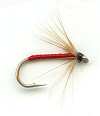Red Soft Hackle
Soft Hackle North Country Red Spider Wet Flies are ideal for imitating egg laying spent spinners caught in the water and dragged under the surface. They are also useful when bloodworm are on the trout's menu.

SOFT HACKLE NORTH COUNTRY SPIDER WET FLY PATTERNS. Hook size 12 14 - $US each
Soft Hackle trout fly patterns like the Partridge and Red are good at imitating spent female egg laying spinners as well as ascending pupa just before a hatch of Mayfly or Caddis. A number of female spinners, known as imagos from the Baetidae family go underwater to lay their eggs. They are extremely vulnerable to predation hungry trout during this phase of their life cycle. The most common species use this method of a egg laying are the large dark olive, medium olive, small dark olive and some iron blues.
The female spinner having crawled down on the rock or aquatic plant stem, having laid her eggs, tries to crawl back out again. Normally she is so tired and weak from the ordeal that she is swept away by the current. Abdomen colours of different species vary from yellowy brown, dull dark brown to a brick red. The Soft Hackle Partridge and Red fly pattern is a good choice for the last fly in that list.
Female spinners of many other species are also at risk of becoming food for the lurking trout and Grayling. They lay their eggs by dipping their tail broadcasting the eggs over the surface. Many of these females end up floating on the surface with their wings spread out fully spent, with no energy left to fly away from this watery grave. These bodies get dragged underwater as they go through turbulence in the River or stream system. This is when they become a tasty snack for hungry non-surface feeding fish.
The Partridge and Red soft hackled wet fly is also a good choice when there are bloodworm available for Trout and Grayling to feed upon. The lava of some species of midges (Chironomidae) that live in oxygen-poor or stagnant water are called bloodworms. Their red coloration is due to the presence of haemoglobin in their body fluids. They live either on the bottom among debris inside small tubes made of a gelatinous substance coated with silt particles or some types swim freely. They are an important source of food for many freshwater fish. There can be as many as four generations in a year. Fish your Partridge and Red bloodworm fly deep and retrieve it very slowly whilst quivering your hand.
LINKEDIN READER'S COMMENT
I have fished soft hackle flies as single flies in dead drift nymph fashion the allowed the current to bring them to the surface. There I usually "skitter" them a little bit before picking up for another cast. Another technique is to get them to the surface, do a hand twist retrieve and then let the retrieved line go along with 8 or so inches more. The current will carry the fly down stream on the surface or just under depending on current flow and weight on the line. Next time bring the fly back to the surface in a slightly different place. This can be repeated a couple of times to cover the water at the end of the drift. I have also fished them on the tail end of a two or three nymph rig with most strikes on the swing at the end of the drift. I have also tried them as the point fly in the rig but usually have better success when the wet fly is the tail fly in the rig. By Marshall Estes
LINKEDIN READER'S COMMENT
Soft hackle is yet another recent American re-naming and claiming of something old and traditional well known in Scotland, England and other parts of Europe. Spider patterns have existed for hundreds of years and the classic work is "The Practical Angler or The Art of Trout Fishing More Particularly Applied to Clear Water" by W. C.Stewart. Upstream fishing with wet flies is an amazing and skilful way to catch fish. You will find the book fascinating!
- By The Alastair (Ally) Gowans

